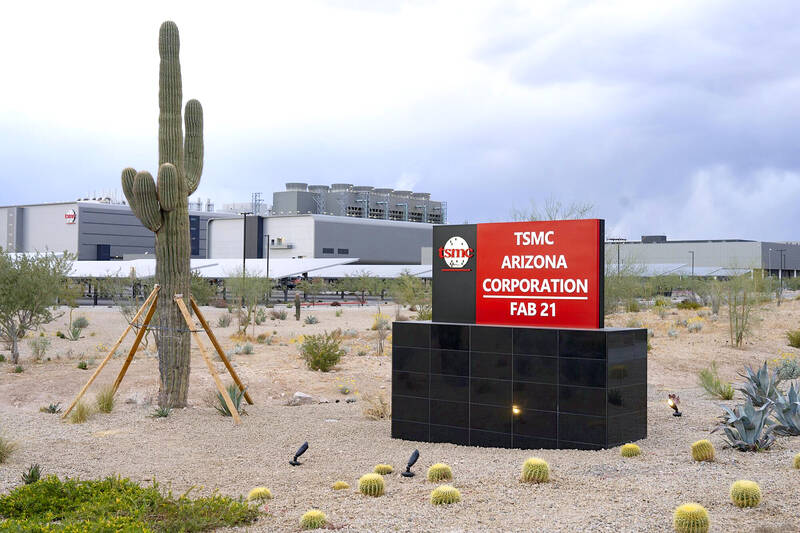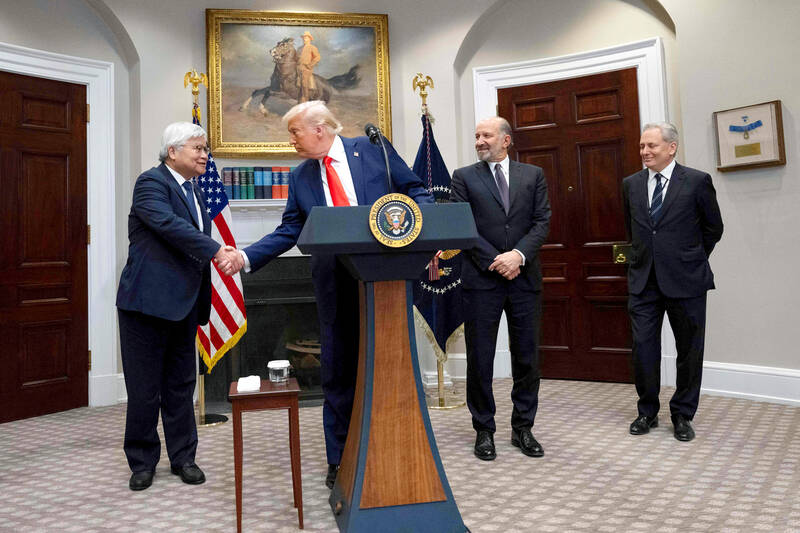Taiwanese chip-making giant Taiwan Semiconductor Manufacturing Co (TSMC) plans to invest a whopping US$100 billion in the US, after US President Donald Trump threatened to slap tariffs on overseas-made chips.
TSMC is the world’s biggest maker of the critical technology that has become the lifeblood of the global economy.
This week’s announcement takes the total amount TSMC has pledged to invest in the US to US$165 billion, which the company says is the “largest single foreign direct investment in US history.”

Photo: Bloomberg
It follows Trump’s accusations that Taiwan stole the US chip industry and his threats to impose tariffs of up to 100 percent — and Taipei’s promises to invest more in the US.
The following is a look at what TSMC’s investment could mean for Taiwan.
‘SILICON SHIELD’

Photo: AFP
Semiconductor chips are used in everything from smartphones and televisions to electric vehicles and missiles — and more than half of them are made in Taiwan.
The concentration of chip manufacturing has long been seen as a “silicon shield” protecting the country from an invasion or blockade by China — and an incentive for the US to defend it.
China has upped military pressure on Taiwan in recent years to press its unfounded claim of sovereignty over the country, where TSMC has its headquarters and the bulk of its fabrication plants.
That has fueled calls for the firm to move more of its production out of the country to avoid supply disruptions if China did attack. Trump recently warned of import levies of 25 percent, or higher, on overseas-made chips, which one analyst has said could trigger a recession in the industry.
While TSMC’s latest investment might deflect the threat of tariffs, there are fears it could hurt Taiwan’s economy and weaken its “silicon shield.”
“The more TSMC produces in the United States, the less important Taiwan will be in geopolitics and the less incentives the United States will have to help Taiwan in the future,” said Ko Ju-chun (葛如鈞), a lawmaker with the main opposition Chinese Nationalist Party.
CONTROL OF TSMC
Taiwan’s leaders are aware of the risks as they try to stay onside with their most important security backer Washington and protect the nation’s status as a chip-making powerhouse.
President William Lai (賴清德) office said Tuesday the government would review TSMC’s deal “in accordance with the law” and ensure that the “most advanced” chip-making processes stayed in Taiwan.
TSMC had already pledged to invest more than US$65 billion in three factories in the US state of Arizona, one of which began production late last year. The US$100 billion investment will be used to expand its US footprint further, with three new fabrication plants, two advanced packaging facilities and a research and development team center.
Richard Hu (胡瑞舟), deputy director of the Taiwan Center for Security Studies think tank, said Trump wanted to prevent TSMC from falling into China’s hands and to make it a “technological asset of the United States.”
“Trump’s ultimate goal is to ensure that the US can fully or critically control TSMC’s semiconductor production, making it a de facto part of America’s chip industry,” Hu said.
DEFENSE GUARANTEES
Taipei security analyst Su Tzu-yun (蘇紫雲) was more optimistic, saying that TSMC’s investment would make Taiwan “safer” and help grow the chip industry.
It would also build trust between Taipei and Washington, and ease Trump’s concerns about US economic security, said Su, from the Institute for National Defense and Security Research.
“I think the importance of Taiwan is not only TSMC but also the geostrategy,” Su said, noting the importance of global shipping lanes near Taiwan.
However, James Yifan Chen of Tamkang University said higher manufacturing costs in the US would drive up prices of products using TSMC chips.
And there were no guarantees the investment would make the mercurial Trump more inclined to defend Taiwan.
“The deal’s effect on US willingness to defend Taiwan is unclear,” said Sung Wen-Ti (宋文笛), a nonresident fellow with the Atlantic Council’s Global China Hub.
“It really depends on how Trump feels on any particular day, and whether Beijing will attempt to outbid Taiwan subsequently.”

April 14 to April 20 In March 1947, Sising Katadrepan urged the government to drop the “high mountain people” (高山族) designation for Indigenous Taiwanese and refer to them as “Taiwan people” (台灣族). He considered the term derogatory, arguing that it made them sound like animals. The Taiwan Provincial Government agreed to stop using the term, stating that Indigenous Taiwanese suffered all sorts of discrimination and oppression under the Japanese and were forced to live in the mountains as outsiders to society. Now, under the new regime, they would be seen as equals, thus they should be henceforth

Last week, the the National Immigration Agency (NIA) told the legislature that more than 10,000 naturalized Taiwanese citizens from the People’s Republic of China (PRC) risked having their citizenship revoked if they failed to provide proof that they had renounced their Chinese household registration within the next three months. Renunciation is required under the Act Governing Relations Between the People of the Taiwan Area and the Mainland Area (臺灣地區與大陸地區人民關係條例), as amended in 2004, though it was only a legal requirement after 2000. Prior to that, it had been only an administrative requirement since the Nationality Act (國籍法) was established in

With over 80 works on display, this is Louise Bourgeois’ first solo show in Taiwan. Visitors are invited to traverse her world of love and hate, vengeance and acceptance, trauma and reconciliation. Dominating the entrance, the nine-foot-tall Crouching Spider (2003) greets visitors. The creature looms behind the glass facade, symbolic protector and gatekeeper to the intimate journey ahead. Bourgeois, best known for her giant spider sculptures, is one of the most influential artist of the twentieth century. Blending vulnerability and defiance through themes of sexuality, trauma and identity, her work reshaped the landscape of contemporary art with fearless honesty. “People are influenced by

The remains of this Japanese-era trail designed to protect the camphor industry make for a scenic day-hike, a fascinating overnight hike or a challenging multi-day adventure Maolin District (茂林) in Kaohsiung is well known for beautiful roadside scenery, waterfalls, the annual butterfly migration and indigenous culture. A lesser known but worthwhile destination here lies along the very top of the valley: the Liugui Security Path (六龜警備道). This relic of the Japanese era once isolated the Maolin valley from the outside world but now serves to draw tourists in. The path originally ran for about 50km, but not all of this trail is still easily walkable. The nicest section for a simple day hike is the heavily trafficked southern section above Maolin and Wanshan (萬山) villages. Remains of